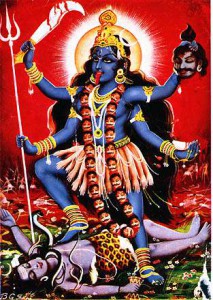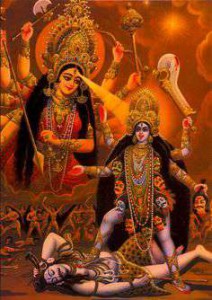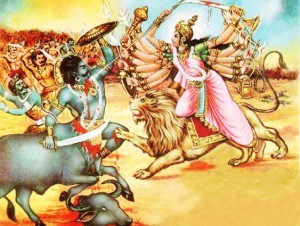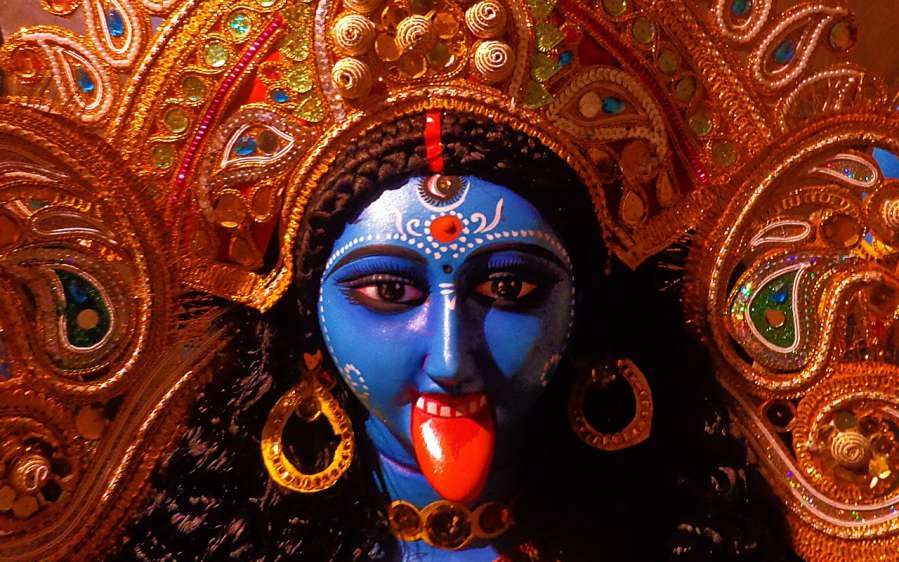No products in the cart.
Kali comes from the Sanskrit root word Kal which means time. There is nothing that escapes the all-consuming march of time. In Tibetan Buddhism her counterpart is male with the name Kala. Mother Kali is the most misunderstood of the Hindu goddesses.
It is partly correct to say Kali is the goddess of death but she brings the death of the ego as the illusory self-centered view of reality. Nowhere in the Hindu stories is she seen killing anything but demons nor is she associated specifically with the process of human dying like the Hindu god Yama (who really is the god of death). It is true that both Kali and Shiva are said to inhabit cremation grounds and devotees often go to these places to meditate. This is not to worship death but rather it is to overcome the I-am-the-body idea by reinforcing the awareness that the body is a temporary condition. Shiva and Kali are said to inhabit these places because it is our attachment to the body that gives rise to the ego. Shiva and Kali grant liberation by removing the illusion of the ego. Thus we are the eternal I AM and not the body. This is underscored by the scene of the cremation grounds.
Of all the forms of Devi, She is the most compassionate because she provides moksha or liberation to her children. She is the counterpart of Shiva the destroyer. They are the destroyers of unreality. The ego sees Mother Kali and trembles with fear because the ego sees in her its own eventual demise. A person who is attached to his or her ego will not be receptive to Mother Kali and she will appear in a fearsome form. A mature soul who engages in spiritual practice to remove the illusion of the ego sees Mother Kali as very sweet, affectionate, and overflowing with incomprehensible love for her children.
Iconography of Goddess Kali
 Maa Kali wears a garland of skulls and a skirt of dismembered arms because the ego arises out of identification with the body. In truth we are beings of spirit and not flesh. So liberation can only proceed when our attachment to the body ends. Thus the garland and skirt are trophies worn by her to symbolize having liberated her children from attachment to the limited body. She holds a sword and a freshly severed head dripping blood. As the story goes, this represents a great battle in which she destroyed the demon Raktabija. Her black skin represents the womb of the quantum manifest from which all of creation arises and into which all of creation will eventually dissolve. She is depicted as standing on Shiva who lays beneath her with white skin (in contrast to her black or sometimes dark blue skin). He has a blissful detached look. Shiva represents pure formless awareness sat-chit-ananda (being-consciousness-bliss) while she represents “form” eternally supported by the substratum of pure awareness.
Maa Kali wears a garland of skulls and a skirt of dismembered arms because the ego arises out of identification with the body. In truth we are beings of spirit and not flesh. So liberation can only proceed when our attachment to the body ends. Thus the garland and skirt are trophies worn by her to symbolize having liberated her children from attachment to the limited body. She holds a sword and a freshly severed head dripping blood. As the story goes, this represents a great battle in which she destroyed the demon Raktabija. Her black skin represents the womb of the quantum manifest from which all of creation arises and into which all of creation will eventually dissolve. She is depicted as standing on Shiva who lays beneath her with white skin (in contrast to her black or sometimes dark blue skin). He has a blissful detached look. Shiva represents pure formless awareness sat-chit-ananda (being-consciousness-bliss) while she represents “form” eternally supported by the substratum of pure awareness.
By not understanding the story behind Mother Kali it is easy to misinterpret her iconography. In the same way one could say that Christianity is a religion of death, destruction and cannibalism in which the practitioners drink the blood of Jesus and eat his flesh. Of course, we know this is not the proper understanding of the communion ritual.
Kali and Mahishasura – Slaying of the Demon by the Goddess
When the Gods lay exhausted after warring with the demons, the evil-natured demon king Mahishasura took the opportunity to assemble an army and declare himself Lord of Heaven, Ruler of the Universe.
This blasphemy reached Vishnu’s ears and, in anger, he shot forth a terrible light from his forehead. Shiva, too, was angry. Ascended from his lofty state of meditation and beamed a sharp ray of blinding light in the same direction as Vishnu. Brahma, Indra and the other mighty Gods did likewise, each issuing forth piercing rays of light. All the Gods’ rays joined at one point and, slowly, the blazing concentration of light took shape in the form of a woman.
The light of Shiva formed her face; Yama gave her hair and Vishnu her arms. From the light of Chandra, the moon God, her two breasts were formed. Indra modeled her waist and Varuna her thighs. Earth gave her hips and Brahma gave her feet. The light from the fire God, Agni, fashioned her three eyes. Thus, all gods contributed their power to manifest the auspicious Devi, the great Mother Goddess (“Devi” is derived from the Sanskrit root word “div” which means “to shine” – the Shining One).
As soon as the Devi was fully formed, the Immortals prayed to her and worshiped her with praise, ornaments and weapons. Shiva gave her a trident drawn forth from his own, Vishnu a powerful discus, and Indra, the king of the Gods, gave her a thunderbolt identical to his own. Surya, the sun God, bestowed his rays on all the pores of her skin, and Varuna, God of the ocean, gave her a divine crest jewel, earrings, bracelets and a garland of unfading lotuses.
“Victory to the Mother,” shouted the Gods as they watched the demon battalions approach with the beating of drums, battle cries, and the blowing of conches. Since the
Devi was of enormous size and highly visible, the demons marched straight toward her, attacking from all sides with arrows, clubs, swords, and spears.
Unperturbed, the Devi roared loudly and laughed a frightening, defiant laugh. Again. And again. And then her ten arms rotated, alternately smashing weapons of the demons and hurling them back at her attackers. With great ease, she picked up dozens of demons at once, killing them with her sword. Some demons she didn’t even bother to pick up. She stupefied them with the tremendous noise of her bell and then crushed them with her mace.

The demon Raktabija gave the fierce Mother Goddess a fair amount of troubles. He possessed a special magical power which allowed him to create new demons from his own blood. Whenever the Goddess wounded him, each drop of blood that spilled to the ground sprouted another demon full of strength and brutality. But in the end the Mother outwitted him. She picked up Raktabija and lifted him high into the air to avoid spilling his blood on the ground, and then, gnashing him between her teeth, she drank his blood and swallowed him whole.
Other demons, too, tried to confuse the Goddess with their magical powers. Whenever they were threatened by the Devi, they changed their form and color. But, who can escape the great Mother? Bound by her noose and spitting blood, these demons were soon caught by the Devi. And like a child pulling a toy train, she dragged them over the battlefield where scores of demons already lay split into two by the sharp slashes of her sword.
Snatching some elephants with one hand, the Devi flung them into her mouth and, together with the demon drivers, she furiously ground them up with her teeth. She seized one demon by the hair and another by the neck. One she crushed by the weight of her foot and another she crushed with her body.
The Mother’s terrible presence filled even the sky. Black clouds gathered and terrifying lightning lit up the ghastly shapes on the ground. There were demons without arms, without legs, and demons torn asunder in the middle of their trunks.

When Mahishasura, the king of the demons, saw his army devastated by the blows of the terrible Mother Goddess, his fury knew no bounds. He expanded his body to take on the fierce shape of a giant buffalo. Intoxicated with his own strength and valor, he roared and charged toward the Devi.
“Roar, roar, O fool,” shouted the Goddess. “Roar for a moment. When you are slain by me, the gods will soon roar in this very place.”
The earth began to tremble under the stomping feet of the Goddess. Mahishasura fought with all his might but could not conquer the Devi. So he appealed to her sense of justice, complaining that she fought in an unfair way. The Devi, he claimed, received help from so many fierce Goddesses – Maa Durga, Kali, Chamunda, Ambika, and others – and he, Mahishasura, had to fight all by himself.
“I am all alone in the world here,” thundered the Devi. “Who else is there besides me? See, O vile one, these Goddesses are but my different powers which again enter into my own self. I stand alone. Don’t back off; defend yourself.”
The savage fight continued, and the great demon attacked the Mother Goddess with showers of arrows. He hurled discuses, swinging his clubs and mace. To no avail. The Devi killed him with her spear, releasing the soul from its evil-natured body and mind.
Dust clouds carried the stench of singed skin and rotting flesh to the blood-red horizon. The demons had been killed, and their blood flowed, accumulating here and there in small pools around the carcasses of elephants and horses. Only some headless torsos of demons who refused to give up life still fought the Devi. The battle shrieks had died and the only cries now were those of jackals and hyenas. There was nothing left to kill, but the blood-intoxicated Mother in the form of Kali continued the carnage – smashing and slashing dead demons all over again.
The Gods, who had begun to celebrate victory, became filled with fear. Who was going to stop her? There was only one who could: Shiva, the great God. Besmeared with ashes, the third God of the Hindu Trinity went to the battlefield and lay down motionless among the corpses while the rest of the Gods watched from a safe distance.
The intoxicated Kali staggered across corpses until, suddenly, she found herself standing on top of a beautiful male body – nude and besmeared with white ashes. Awed, she stood still for a moment, looked down at him, and saw straight into the eyes of her husband Shiva. When she realized that she was touching her divine husband with her feet – an unthinkably disrespectful act for a Hindu wife – Kali stretched out her tongue in shame and the destruction came to an end. Read Devi Mahatmyam – A Detailed Version of the Fight Between Devi and Mahishasura
The Meaning of the Story of Kali and Mahishasura
For those who have grappled with their own ego, the personification of the demons in this story is striking. When the demons first glimpsed the Mother they charged. The darkness sees the light and does not comprehend it. The ego attacks that which it does not understand or that which threatens it.
The demon with the magical power of sprouting a new demon each time a drop of its blood reaches the ground is reminiscent of spiritual pride. This is the power of the ego to inflate itself over “perceived” success in making spiritual progress. Thus spiritual progress is next to impossible as long as spiritual pride keeps sprouting a new demon each time the ego is slashed by some spiritual insight or experience. The ego whispers in our ear, “See what a great spiritual aspirant you are.”
Other demons changed form when threatened by the Devi. The ego shifts its position with astounding cunning by the power of rationalization. Mahishasura, the demon king, was intoxicated with his strength and valor and changed into a buffalo. The ego is always consumed with self-importance. When he saw that he was not winning, he tried to fool the Mother with self-pity and claimed that her many forms were an unfair advantage. The Mother saw through the ploy and destroyed his self-pity with the Truth stating that there was only one Mother. The ego was destroyed and the soul found liberation in her quick and deadly spear of compassion.






